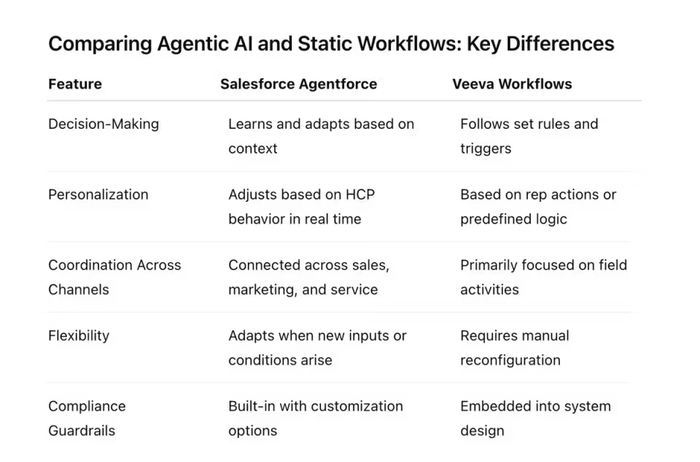The Rise of Agentic AI in Pharma: Salesforce Agentforce vs. Veeva's Static Workflows
Jul 22, 2025 | 4 min read

Pharma’s AI Evolution Is Picking Up Speed
Artificial intelligence (AI) in pharma is no longer just about speeding up reports or summarizing meeting notes. It’s evolving into something much more impactful—tools that can make decisions and take action on their own. That’s the heart of what’s called agentic AI.
In this blog, we compare how Salesforce’s Agentforce and Veeva’s workflows approach AI. Both are trusted names in life sciences, but they’re taking different routes toward automation. One offers dynamic, adaptable support. The other delivers structure and control. Understanding these differences is key to choosing the right fit for your commercial and medical teams.
What Is Agentic AI—and Why Should Pharma Teams Care?
Agentic AI means systems that don’t just give recommendations—they can actually perform tasks for you. This might include:
- Sending a personalized email to a healthcare provider (HCP)
- Drafting a response to a medical inquiry
- Automatically updating records or triggering follow-up actions
These systems act based on real-time inputs and learned behavior, not just pre-set rules. For example, if an HCP opens a new clinical resource, agentic AI could automatically follow up with related content or alert a field rep.
In a highly regulated industry like pharma, these smart systems can make day-to-day tasks faster and more precise—while staying within compliance boundaries.
Salesforce Agentforce: Smart, Flexible, and Built to Learn
Salesforce Agentforce is designed to help pharma teams work more efficiently by using AI to handle tasks automatically. It’s part of Salesforce’s larger Einstein 1 Platform, which brings together real-time data and AI-driven decision-making.
Some tools powering Agentforce include:
- Einstein Copilot: A chat-like assistant that understands what you need and helps you get it done
- Data Cloud: A centralized place that connects all your customer and engagement data in real time
- Prompt Builder: A tool that lets your team define what the AI can or cannot do, keeping things safe and compliant
Example for Commercial Teams:
A brand manager wants to reconnect with HCPs who didn’t attend a recent webinar. Instead of manually sorting through lists, Agentforceidentifies the right audience, drafts emails using pre-approved content, and schedules delivery.
Example for Medical Affairs:
A field rep gets a complex question from an HCP. Agentforce reviews similar past inquiries, drafts a reply, and routes it to the review team—all without the rep needing to search through documents.
Bottom Line: Salesforce Agentforce learns and adapts, helping teams focus on decisions and strategy—not repetitive tasks.
Veeva Workflows: Reliable, Rule-Based, and Structured
Veeva’s workflows are part of the Vault platform, which is well-known in pharma for its focus on compliance. These workflows guide teams through repeatable, rule-based steps to manage content, field activity, and medical communications.
Common features include:
- Approved Email: Pre-written, compliant emails reps can send after meetings
- PromoMats and MedComms: Tools that help review and approve materials through medical, legal, and regulatory (MLR) workflows
- Event Capture: Structured tracking of meetings, samples, and follow-up actions
Example for Commercial Teams:
After an HCP visit, a rep selects from a list of pre-approved emails and sends follow-up materials. The email is tracked in the system and linked to the rep’s activity.
Example for Medical Affairs:
An inquiry submitted by a healthcare provider is logged, then sent through a predefined series of review and response steps in Vault.
Bottom Line: Veeva workflows are great for repeatable, structured processes—but they don’t adjust automatically based on behavior or real-time signals.
Comparing Agentic AI and Static Workflows: Key Differences

Key Takeaway: Agentforce gives teams more flexibility and speed, while Veeva offers stability and control. Choosing between them depends on how much adaptability your team needs.
How to Prepare for AI in Pharma Workflows
AI adoption doesn’t happen overnight, and most pharma teams use a mix of systems. Here are a few ways to start planning for agentic AI:
- Spot bottlenecks: Are reps or medical teams spending too much time on repetitive tasks?
- Start small: Use AI for tasks like content suggestions, segmentation, or inquiry routing
- Keep compliance top of mind: Guardrails like Prompt Builder and approval workflows help AI stay within bounds
- Train teams gradually: Tools like Einstein Copilot work best when users feel comfortable giving clear instructions
Real-Life Use Case:
A company uses both Salesforce and Veeva. They start with Agentforce to automate low-risk campaigns (like follow-ups from event attendees), while keeping medical responses within Veeva’s structured workflows. Over time, they expandAgentforce to help coordinate between sales, service, and marketing teams.
Key Takeaway: You don’t have to choose one platform for everything. The key is to use the right tool for the right task—and align your AI plans with your business goals.
Conclusion: Choosing a Platform for Tomorrow’s AI Needs
Veeva’s static workflows offer clear, consistent processes that are especially valuable in highly regulated situations. Salesforce Agentforce, on the other hand, brings in smart automation that can act and adapt in real time.
Both platforms support the needs of life sciences teams—but in different ways. If your organization is aiming to scale personalization, reduce manual effort, or coordinate across multiple functions, agentic AI may offer the flexibility you need.
Ready to explore how AI could transform your commercial or medical workflows?



 Gradial
Gradial  PEGA
PEGA 




